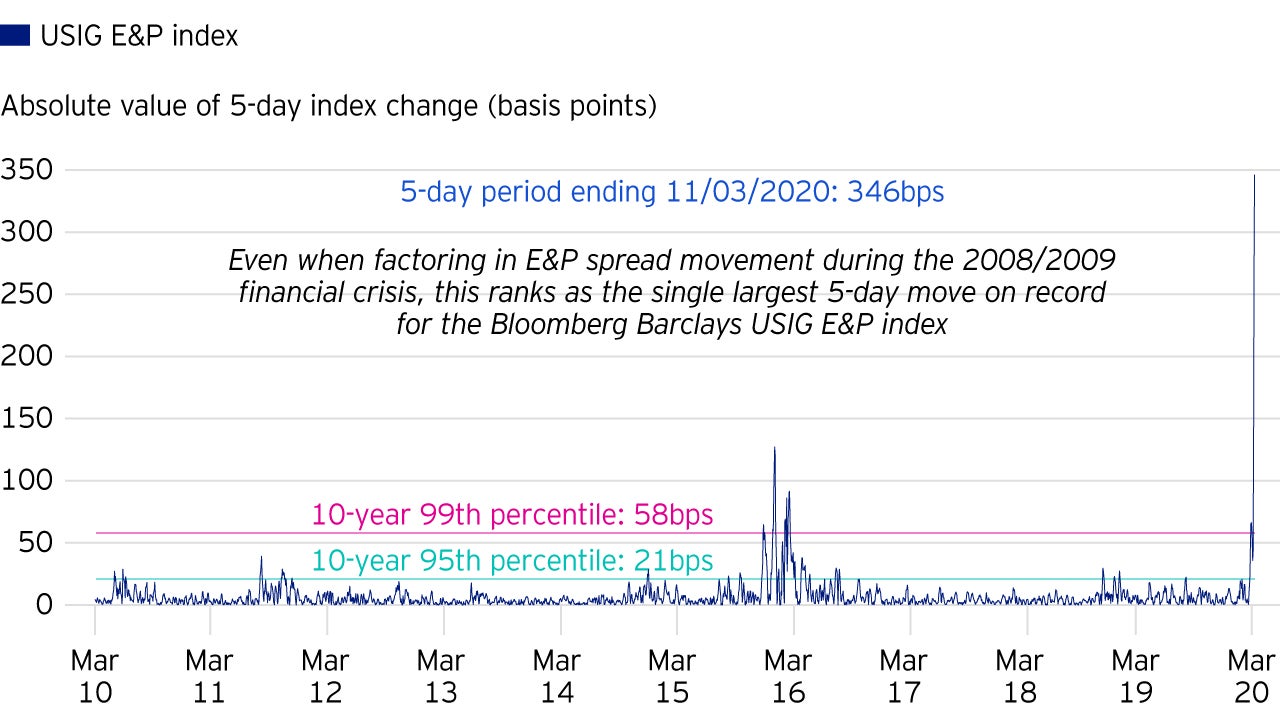The coronavirus impact on fixed income markets

A fundamentals-driven correction that may take some time to resolve.
Macro impact
The spread of the coronavirus globally has continued unabated in recent weeks. The combination of “business as usual” in Europe and the US and limited testing has exacerbated the issue and increased uncertainty regarding the extent of the outbreak and the ultimate path the outbreak will take. As policymakers take more aggressive measures to control the spread of the virus, we will likely see a large impact on global growth. As the extent of the outbreak has expanded, investors have had to price in a larger impact on growth over a longer period.
Invesco Fixed Income expects Q1 growth in the US and Europe to be weaker than expected and Q2 growth to be significantly negative, as these economies are hit by fear and the impact of measures implemented to contain the virus. The path forward also remains very uncertain, which is a headwind for markets.
China provides a model for us to think about what lies ahead. China implemented strong measures to control the virus, which has hit the economy badly in Q1. China has now controlled the outbreak and is in the process of returning to work. Once the level of daily infection peaked, the process of returning to work started. Infections in the US and Europe are still rising, and it is likely the epidemic will take a while to peak in these regions. It is the impact on growth and uncertainty around the virus propagation that is causing current market action.
It is very important to acknowledge that we believe this is a fundamentals-driven correction, which makes it very different than a financial crisis. The resolution of this situation will likely take time as we watch the epidemic play out in the US and Europe. Financial conditions-driven crises, such as the one in Q4 2018 and the Global Financial Crisis can be resolved quickly by central banks. In the case of fundamentals-driven crises, central banks can only ameliorate, not solve, them. We expect this market to follow a U pattern rather than a V.
We expect risk assets to continue to be volatile, and markets will likely take a while to bottom. US interest rates have been the shock absorber, but there is little room for bonds to rally further, in our view, as we do not expect the US Federal Reserve (Fed) to embrace negative interest rates. The Fed will likely cut rates close to zero, but we expect the yield curve to remain positively sloped. Lower US interest rates will likely erode the interest rate advantage of the dollar versus other developed market currencies, which will likely weigh on the dollar going forward versus other developed market currencies.
Energy sector impact
In a one-two punch, the impact of the coronavirus was magnified by OPEC action that dramatically impacted the price of oil. The failure of OPEC and key non-OPEC oil producers, notably Russia, to coordinate production cuts and subsequent production increases by Saudi Arabia precipitated a plunge in oil prices at the same time that fears over the spread of the coronavirus mounted. We expect oil demand to face significant year-over-year declines in the first quarter of 2020 amid excess supply, which should continue to weigh on oil prices.
Oil prices at $30/barrel (bbl) is punishing for most domestic producers, however, the duration of the oil price weakness is a major concern for creditors. While many producers currently benefit from robust liquidity profiles, an extended period of oil at $30/bbl could quickly result in rapid liquidity consumption, increasing credit risk for the entire sector.
Perhaps not unexpectedly, the market reaction to this oil-related news has been strongly negative. US investment grade exploration and production (E&P) credit spreads – the difference between the yields of US Treasury vs. non-US Treasury securities of similar maturity — have widened by 311 basis points, meaningfully underperforming the Bloomberg Barclays US Credit Index (36 basis points wider) and the Bloomberg Barclays US Midstream Index (116 basis points wider).1 This compares to average weekly changes in the Bloomberg Barclays US E&P Credit Index and the Bloomberg Barclays US Credit Index of 7 and 3 basis points, respectively, over the past 10 years.2 Amid heightened market and sector volatility, bid-ask spreads (the difference between the highest price a buyer is willing to pay for a security vs. the lowest price a seller is willing to accept) have also widened dramatically. Without coordinated supply support from OPEC and Russia, and with oil demand under pressure, we expect energy credit to continue trading with an elevated level of volatility and uncertainty in the near term.

Energy outlook
Uncertainty about the duration of oil price weakness remains a key concern for investors in the US investment grade energy sector. While we are actively monitoring the impact on corporate fundamentals, we are tracking energy company liquidity profiles as well. We expect rating agencies to announce downgrades in the near term across energy sub-sectors as they reduce oil price assumptions. While the long-term corporate fundamentals for the energy industry remain uncertain at such weak commodity prices, we believe certain robust liquidity profiles raise the attractiveness of some short-term bonds that have been indiscriminately punished by this broader sector selloff, despite a high likelihood of repayment, even in a weak oil price environment. Although forecasting commodity prices consistently and accurately is challenging, we believe assessing near-term liquidity can be done with higher conviction. While we are extremely cautious in this volatile market environment, Invesco Fixed Income continues to seek unique investment opportunities that exhibit attractive risk-adjusted return potential while maintaining a focus on capital preservation during this historically unprecedented time for the US energy sector.
Consumer sector impact
The US consumer has the served as the backbone of the US domestic economic expansion for more than a decade. Robust employment trends, low interest rates, and lower taxes have driven confidence levels to record levels, resulting in robust consumer expenditures. Demographics are also supportive as millennials are now proceeding down the same path as previous generations, buying homes and starting families. The long-term trend is now at risk, however, as the uncertainty surrounding the coronavirus impacts multiple facets of consumer spending. The ability of the US consumer to spend is not in question, but only their desire, as the country faces a period of uncertainty. Invesco Fixed Income shares the following views on key consumer spending sectors:
Travel (airlines, hotels, gaming, cruise lines and online travel agencies)
Americans love to travel and have the resources to do it. We expect travel plans to be changed or postponed rather than outright cancelled to avoid group travel and with a preference for destinations that have less exposure to large crowds. We expect theme parks, musicals (New York City), and sporting events to suffer in favor of beaches, national parks, and family reunions. Consumer balance sheets are robust enough to get through a moderate business stagnation, in our view, but negative rating agency actions are likely on the horizon.
Retail
Spending trends have remained intact, although we are seeing spending shifting to “stockpiling” essentials such as water and disinfectant, etc. We expect dollar stores, discounters, auto part retailers, warehouses, grocers and other suppliers of essentials to see modest gains to modest declines in sales, depending on the specific company. We expect apparel stores to see less traffic, but we anticipate a material shift to online shopping as consumers stuck at home continue to shop online.
Restaurants and Leisure
We expect the impact to be less than travel but more than retail. Table service dining will likely be hit much harder than restaurants with delivery or drive-through options. Starbucks stores, for example, were around 60% closed during the height of the outbreak in China, but most have reopened, with less than 10% remaining closed.
Market reaction has been very diverse within the consumer sector versus the Bloomberg Barclays US Aggregate Bond Index which is now 80 basis points wider compared to the previous month.3 Restaurants and retailers have performed roughly in line with the market, but leisure has materially underperformed, with some 10-year bonds 550 to 250 basis points wider over the past month.3
Bank liquidity is solid
In the wake of the 2008 financial crisis the Basel Committee on Banking Supervision produced a new set of regulatory standards for the banking industry worldwide that significantly strengthened bank liquidity and capital. Banks are now subject to more stringent liquidity requirements, such as the Liquidity Coverage Ratio (LCR), which addresses the minimum liquidity banks must have on hand to meet a potential run on the banks and potential difficulties refinancing short-term obligations in extreme economic or financial conditions, such as those experienced during the Global Financial Crisis of 2008. The LCR requires banks to hold high quality liquid assets (HQLA) that are sufficient to cover the outflows of deposits during stressed economic conditions over a 30-day period. Banks also face stricter capital requirements including the Basel III Tier 1 Leverage Ratio, which is the ratio of Tier 1 Capital (equity capital and disclosed reserves) to its consolidated assets. The ratio includes off-balance sheet exposures, such as credit lines, in its calculation of consolidated assets, so banks are already holding Tier 1 capital against these commitments and are not capital constrained.
Impact on market liquidity
Despite the strengths of the financial system, the sharp price moves and increased volatility are impacting fixed income market liquidity. Bid-ask spreads (the difference between the price at which you can buy a security vs. the price at which you can sell it) have widened, and liquidity in cash credit bonds can be hard to find. On the other hand, trading volumes are solid, and markets are functioning. On Thursday, the Fed announced facilities designed to ensure that a liquidity event does not develop from this fundamental shock. We expect central banks to continue supporting the liquidity of the market, although their actions cannot directly impact the cause of the current correction and will likely have limited impact on the path of this correction.
With contributions from Bixby Stewart, Senior Analyst – Energy; Ray Janssen, Senior Analyst – Consumer; and Matt Bubriski, Senior Analyst – Bank Liquidity, Invesco Fixed Income.
End notes
1 Source: Bloomberg Barclays, data as of 03/11/2020 a. USIG independent energy Option-Adjusted Spread (OAS) of 580 at 03/11/2020 is 311bps and 115% wider than the 03/06/2020 level of 269
b. USIG credit index OAS of 172 at 03/11/2020 is 36bps wider than the 03/06/2020 level of 136
c. USIG midstream index OAS of 358 at 03/11/2020 is 116bps wider than the 03/06/2020 level of 242
2 Source: Bloomberg Barclays, data as of 03/11/2020-
Calculated as the average of the 10-year absolute value of weekly (5-day) OAS changes for the USIG credit index and the USIG E&P credit index (a sub-sector within the USIG credit index)
3 Source: Bloomberg Barclays, data from Feb. 12, 2020 to March 12, 2020.
Investment risks
- The value of investments and any income will fluctuate (this may partly be the result of exchange-rate fluctuations) and investors may not get back the full amount invested. Debt instruments are exposed to credit risk which is the ability of the borrower to repay the interest and capital on the redemption date.
Important information
- This article is marketing material and is not intended as a recommendation to invest in any particular asset class, security or strategy. Regulatory requirements that require impartiality of investment/investment strategy recommendations are therefore not applicable nor are any prohibitions to trade before publication. The information provided is for illustrative purposes only, it should not be relied upon as recommendations to buy or sell securities. By accepting this article, you consent to communicate with us in English, unless you inform us otherwise.
- Where individuals or the business have expressed opinions, they are based on current market conditions, they may differ from those of other investment professionals and are subject to change without notice.


